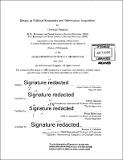Essays in political economics and information acquisition
Author(s)
Reggiani, Giovanni
DownloadFull printable version (10.36Mb)
Other Contributors
Massachusetts Institute of Technology. Department of Economics.
Advisor
Abhijit Banerjee and Bengt Holmstrom.
Terms of use
Metadata
Show full item recordAbstract
This thesis consists of three chapters respectively on optimal contracts to incentivize information acquisition, strategic voting, and conflict of interest. The first chapter, joint work with A. Clark, studies a principal-agent problem with limited-liability where an agent is hired to acquire information and take a decision on behalf of a risk-neutral principal. The principal cannot monitor the agent's attentiveness when acquiring information and so she provides incentives with a contract that depends on the realized state of the world and the chosen decision. We build a model for this problem where the agent's cost of acquiring information is given by the average reduction in entropy. We show that the optimal contract has a linear structure: the agent receives a fixed fraction of output together with a state and decision contingent payment. The optimal contract is simple, in terms of dimensionality, and features an incentive structure analogous to that of portfolio managers in the hedge fund industry. We extend this result to problems with arbitrary utilities, a generalized form of cost functions, a participation constraint for the agent, a wealth constraints for the principal, and imperfect revelation of the state. We also show that only entropic costs can generate the separability of state and decision payments and solve for the equivalent optimal contract in a dynamic setting. Lastly we perform Monte Carlo simulations to test the robustness of our initial contract for different utilities and compare its welfare to purely linear and to unrestricted contracts. The second chapter, joint with F. Mezzanotti, provides a lower bound for the extent of strategic voting. Voters are strategic if they switch their vote from their favorite candidate to one of the main contenders in a tossup election. High levels of strategic voting are a concern for the representativity of democracy and the allocation efficiency of government goods and services. Recent work in economics has estimated that up to 80% of voters are strategic. We use a clean quasi experiment to highlight the shortcomings of previous identification strategies, which fail to fully account for the strategic behavior of parties. In an ideal experiment we would like to observe two identical votes with exogenous variation in the party victory probability. Among world parliamentary democracies 104 have a unique Chamber, 78 have two Chambers with different functions, and only one nation has two Chambers with the same identical functions: Italy. This allows us to observe two identical votes and therefore a valid counterfactual. In addition, the majority premia are calculated at the national level for the Congress ballot and at the regional level for the Senate ballot. This provides exogenous variation in the probability of victory. Because the two Chambers have identical functions, a sincere voter should vote for the same coalition in the two ballots. A strategic voter would instead respond to regions' specific victory probabilities. We combine this intuition with a geographical Regression Discontinuity approach, which allows us to compare voters across multiple Regional boundaries. We find much smaller estimates (5%) that we interpret as a lower bound but argue that it is a credible estimate. We also reconcile our result with the literature larger estimates (35% to 80%) showing how previous estimates could have confounded strategic parties and strategic voters due to the use of a non identical vote as counterfactual. The third chapter estimates the distortions due to conflict of interest during Berlusconi's rule over Italy. The identification is based on the efficient market hypothesis. In particular, I use electoral polls and stock market data to estimate the effect of surprising electoral outcomes, defined as the difference between actual and expected electoral results, on the stock market performance of Berlusconi's firms. I find evidence that there are substantial distortions due to conflict of interest: 6% increase in market capitalization per percentage point of a positive electoral surprise. I then match two of Berlusconi's companies operating in the same media sector but in different countries. This allows me to further test whether the extra returns are due to political distortions under different regulatory authorities. I find that the abnormal returns can be ascribed to "conflict of interest" rather than to the CEO-founder stepping down. Finally, I perform robustness tests to ensure that the cumulative abnormal returns estimates are not spurious.
Description
Thesis: Ph. D., Massachusetts Institute of Technology, Department of Economics, 2016. Cataloged from PDF version of thesis. Includes bibliographical references (pages 95-98).
Date issued
2016Department
Massachusetts Institute of Technology. Department of EconomicsPublisher
Massachusetts Institute of Technology
Keywords
Economics.